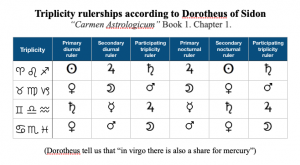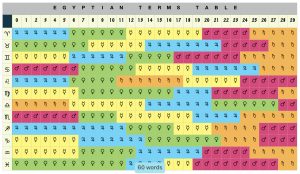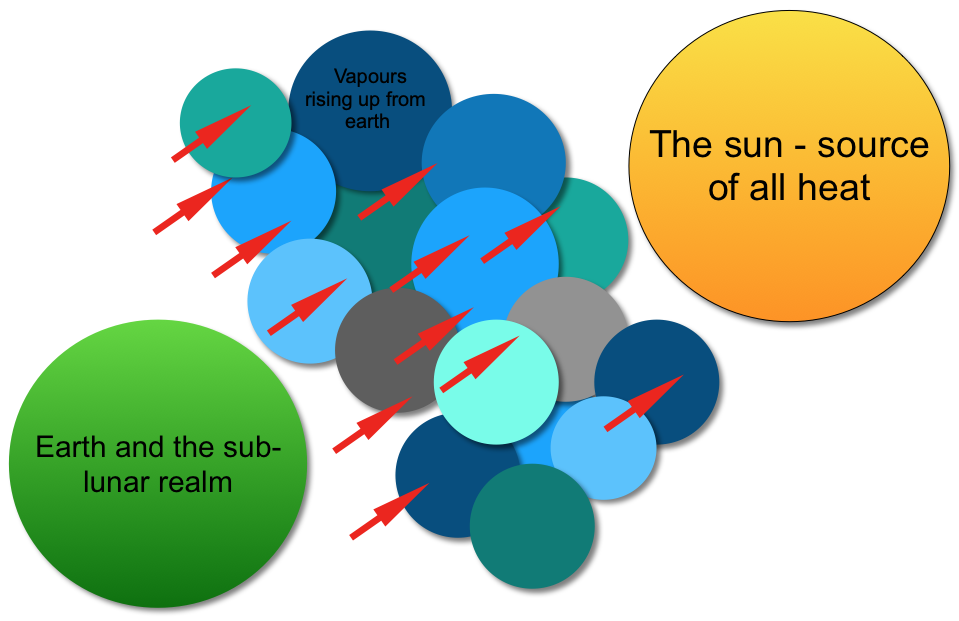
“Musica Universalis” – The Music of the Spheres
The Music of the Spheres
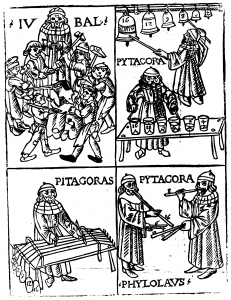
Milan: Philippium Mantegatium. (1492)
Throughout the ages and until fairly recently, the heavens were envisioned as a series of crystalline spheres that rotated one inside the other in accordance with the rhythm of harmonious celestial music.
The proponent of this idea was the philosopher Pythagorus. He had noticed that the hammers used by blacksmiths gave off different tonal notes whilst being used. These notes were dependant upon the hammer’s weight. He established a tone to weight ratio.
This ratio is also apparent in stringed instruments. We hear a stringed instrument being played and see its strings vibrate. Our ears pick up the sounds as they travel through the air. The strings have a musical relationship with each other just like the blacksmith’s hammers but the different sound each string makes is due its length and not it’s weight.
It was generally accepted that moving objects produced sound vibrations and it was a very short step to apply this rationale to the celestial realm as it moved overhead. This in turn gave rise to the theory of “Musica Universalis” or The Music of the Spheres.
Musical theory is based upon numerical proportions and ratios that dictate its rhythms, note lengths and key structures. From the simplest of tunes to complex instrumental arrangements, it is the underlying beat that gives movement to all music and this numerical notation is paramount. Pythagorus believed that the Universe followed suit. The same numerical patterns found in music were the principle components that underpinned everything and set the elements moving in a harmonious way. Numbers and numerical structure were responsible for the order of the universe and its rhythms.
Just as there are 7 notes in a musical scale and 7 ‘classical planets’, so too the Chaldean Order of the planets dictated the distance of each planet the earth and one planet from another. Every planet’s weight, from lightest to heaviest, depended upon their numerical distance from earth. This neatly parallels the blacksmith’s hammers. Pythagorus and other ancient philosopher believed that planets further from the earth had a much graver the note e.g. saturn. Conversely, the moon, the closest heavenly body to earth, has the shrillest note of all.
But why can’t we hear this celestial music? Given the vastness of the universe the sound must be very loud and audible here on earth. Pythagoras surmised that because this music was continuous and as we had been exposed to it from birth we didn’t actually notice it. It could be thought of as a kind of universal background noise. Since we’d never truly experienced real silence we’d nothing to compare it with. This itself raised the idea of the audible and the inaudible, a physical realm that we could experience directly with our 5 senses and a non-physical realm we couldn’t. They both existed side by side.
Although not all philosophers agreed with Pythagorus, this rather lovely idea of the heavenly music of the spheres persists in our modern world.
Temperament. The Four Humoral Men
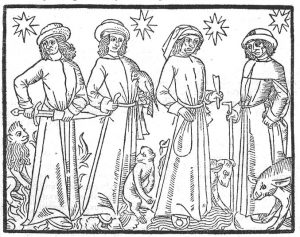
The four strapping lads depicted in this highly descriptive woodcut represent the four humoral temperaments. From left to right they are the choleric, sanguine, phlegmatic and melancholic humors respectively. By the time this woodcut was carved this theory of human temperament had held sway for many, many centuries. It was the dominant theory of Physiology, Psychology and Medicine until the 17th century with parts of it surviving within these disciples until fairly recent times. To this day our language remains peppered with humoral expressions. We have all met people who have a dry sense of humour or others described as a wet blanket. We know the difference between a hot headed individual and a cold blooded one. There are countless other commonplace expressions that spring to mind. These phrases are the legacy of the once commonplace and universally accepted humoral theory that defined our individual temperament. Our temperament informed others of the way we would act and react in various situations and it described our susceptibility to specific illnesses, physical and mental.
Each one of us has our own astrological temperament that was dictated by our specific humoral balance. The humours were associated and governed by a planet. We are reminded of this fact by the lovely, childlike star just above each man’s head. This visual metaphor for the heavenly, spiritual world being reflected onto our earthly plane helps us to understand the traits of each temperament via a planet’s intrinsic humoral nature. In the past there was a belief in a cosmic sympathy that permeated all matter, animated or otherwise, held together by a divine universal spirit. Everything in the celestial and sub-lunar realm was connected to and influenced by everything else.
Each temperament was ruled by one of the four classical elements of fire, air, water and earth and it was commonly understood that they existed inside the body as fluids known as Humours. Least we forget which man is which, if you look at the bottom of the picture you will note that each man stands upon the elemental base associated with his specific humoural type.
On the far left is Mr Choleric standing upon a base flames that are leaping upwards. This represents the element of Fire which corresponds to the humour of Yellow Bile. Both are hot and dry in nature. Yellow bile was thought to have its seat in the gall bladder and it had a bitter taste. It was ruled by mars.
Next comes Mr Sanguine on a base of clouds representing the element of Air which corresponds to the humour of Blood. Both are hot and wet in nature. Blood was thought to contain the other three humours, carrying them around the body to be distributed. It had a sweet taste. It was ruled by jupiter.
Mr Phlegmatic stands upon waves representing the element of water which corresponds to the humour of Phlegm. Both are cold and wet in nature. Phlegm was believed to have its seat in the brain and have a salty taste. It was ruled by the moon.
Finally, on the far right of the picture Mr Melancholic stands upon a foundation of solid earth which corresponds to the humour of Black Bile and both are cold and dry in nature. Black bile was believed to have its seat in the spleen with a sour taste. It was ruled by saturn.
Note the exact horizontal division in this woodcut that is indicated by the alignment of each man’s waist. It effectively splits the picture into two parts.
The more divine, intellectual part of man’s nature is represented by the top half of the picture which is nearer the sky and heaven.
The part that represents our lower bestial nature is on the bottom half of the picture which is closest to the ground where the beasts dwell.
The Elemental Animals
The four elemental men are not alone and each is accompanied by an animal traditionally associated with the humor. Although there are other animals associated with each humor (e.g. the melancholic humour is also associated with the owl) for the purposes of this post I have chosen to use this particular woodcut. These animals will give us clues as to the behaviour and nature of each of the men they are assigned to.
As stated, the animals are in the bottom half of the picture and near the earth. This tells of our basic bestial drives and nature. The sanguine man is different from the others for he has two beast associated with him. One is in the upper half of the picture near the heavenly realm and speaks to us of our of our mentality and higher nature. The other isn’t.
The choleric lion
The lion’s fiery mane is reminiscent of the sun and its rays. It shows intellectual victory over our bestial nature, a good use of our vitality and strength. This is the good side of choleric temperament. A golden lion is the colour of the sun and noble by association. The lion is traditionally the king of beasts, strong and valiant, calm and contented. But the lion hints at the terrors of a darker more, tempestuous side found within the choleric nature. Just like the lion this man can be fidgety, restless and aggressive, quick to anger with a possible savage side. The lion warns of a bloodthirsty nature that kills without remorse with its teeth and claws as sharp as any dagger or sword.
The sanguine monkey
The monkey is human like and linked to our inquisitiveness and curiosity about the world we live in. It seems human but isn’t. Monkeys are adaptable and dexterous, good at mimicking and copying – monkey see, monkey do after all. They are amusing, entertaining and chatter in a way that is reminiscent of human speech. For all the aforementioned reasons monkeys have been linked with intelligence throughout the ages. With a playful, energetic way of behaving which makes them tricky to catch or pin down, they are symbolic of an opportunistic nature and duplicity in all forms which includes sexual duplicity. But all these traits and antics belie their total lack of human understanding. Almost human but not human, we are warned to be on our guard in our dealings with the sanguine man.
The sanguine falcon
The falcon is a creature of the air and signifies acute perception, discernment and freedom as it flies high above the earth. It is all seeing, superb at hunting, homing in on its prey with deft precision, a symbol of victory perched on the sanguine man’s left hand – the more passive side of our nature – ready for action at a moments notice. This reflects the mind of its owner, constantly on the lookout. For although the sanguine man appears to be the calmest of the four men his mind is sharp and never at rest. It can instantly spring into action just like the falcon. The falcon can also symbolise cruelty for it focuses its energies and attributes on the killing of less agile and aware animals.
The phlegmatic sheep
Sheep are passive animals and need to be protected. Shy, gentle and timid in nature they are easily frightened. Since they flock together they are regarded as lacking individuality giving them the reputation of being easily led or even stupid. The ewe is regarded as a passive and harmless animal and the lamb is a very ancient symbol of innocence and vulnerability. Sheep have been used in sacrifices since the earliest of times. The ram however is seen as something completely different. It is a symbol of vitality and unwavering determination. The ram’s horns are effective weapons and their spiral shape remain a symbol of eternity: birth, life, death and rebirth. Sheep are sure footed animals with an innate and excellent sense of balance being good at jumping and climbing. In this respect they were thought to make the best of any opportunities. Sheep are also contented animals. Happily eating the grass beneath them they quietly graze and gently get on with life in their own calm and peaceful way. Peace and calm are the qualities they are renowned for and the image of sheep, jumping over a fence one by one, is reputed to induce sleep. This peaceful nature is what makes the phlegmatic type a good friend to have. They do not jostle and shove and can happilly accept guidance from a more authoritative figure but the phlegmatic type can be guided in the wrong direction.
The melancholic pig
Pigs (and wild boar for that matter) have been a symbol of abundance and fertility since ancient times for there are normally many piglets in a litter and they are tough and resilient animals. They were regarded as a great commodity in the past and readily bartered at markets. Farmers who kept and bred swine were always known to have lots of food. This association of abundance remains with us with the china ‘piggy bank’ being a worldwide symbol of money. Pigs are intelligent animals but they can be ferocious too. The wild boar is a very good hunter of food and can be dangerous if crossed. In the modern world an ambivalent symbolic meaning that is completely at odds with ancients beliefs has emerged. These contented and sedate animals, their eyes downcast towards the earth, are unconcerned with heavenly matters and they happily forage and snuffle in the earth looking for food. They also spend time cooling off in the mud. As a result they have become regarded as unclean and lazy by some cultures. Pigs are omnivores, undiscerning and will eat almost anything that comes their way. They have a voracious appetite so over time the pig has became the symbol of laziness, greed and ill-manners.
The planetary humors

Garden City, N.Y. Doubleday, Doran. (1935)
The sun sits in the middle of heaven. It has three planets above it known as the superior planets. These are mars, jupiter and saturn. It also has three planets below it known as the inferior planets. These are venus, mercury and the moon.
The sun is the source of power and heat in heaven and everybody knows that heat rises.
Ancient philosophers reached the logical conclusion that mars must absorb much of this heat for its sphere lay immediately above that of the sun. Saturn being the furthest away planet from the sun would be the coldest. Jupiter sat between mars and saturn.
Knowing that heat doesn’t sink downwards they reckoned that the three planets below the sun would be colder than the three above. But as venus is closer to the sun’s sphere it would be slightly warmer than the moon which was the furthest away. Mercury sat between venus and the moon.
Ancient astrologers believed that each planet had its own intrinsic humoral quality. They looked at how they appeared in the sky and this helped them to gauge how they would affect life on earth.
They knew that increased moisture and warmth made fruits ripen and swell, becoming plump, juicy and full of goodness. This fruitful analogy was applied to the planets. Planets that glistened and gleamed were assumed to have more moisture that the ones that didn’t. The most obvious example of this is the moon which swells up like a ripening fruit promising great bounty. But although nowhere near the moon’s size both venus and jupiter also glisten and gleam and were considered moist and bountiful too. In the very distant past mercury was actually known as ‘the Glistener’.
But if these planets glistened where did the moisture and warmth come from? Obviously the source of heat came from the sun. In the past it was believed that the earth gave off moist vapours which rose upwards into the atmosphere to be absorbed by the planets. The philosophy of planetary humors soon developed based upon each planet’s position with regard to the sun’s heat and these rising moist vapours.
The sun
The sun invigorates life and vitality with its golden rays of light. The sun has two obvious cycles by which we live our lives, the cycle of day and night and the cycle of the seasons. The sun is the cause of earthly activity and it’s qualities are obvious. It is primarily hot which leads to dryness. This is exactly what happens when the sun evaporates the morning dew or summer comes around. So the sun’s intrinsic humoral nature is hot and dry. It is at sunrise that earthly activity commences, ceasing at sundown when night falls. Daytime then is of the same humoral nature as the sun, hot and dry. The cycle of the seasons reflect this same sequence. Spring and summer are the warmer, dryer and dynamic seasons of the year for it is at spring life awakens following winter. Autumn and winter are the cold, wet and inactive seasons when life goes to sleep. Because the sun instigates earthly activity it is regarded as active and dynamic in nature, qualities associated with men. The sun is regarded as masculine in traditional astrology.
The moon
Far below the heat for the sun is the moon with no intrinsic heat of its own. It is considered as primarily cold. But being closest to earth its absorbs much of the rising vapours and is therefore moist. So the moon’s intrinsic humoral nature is cold and moist. But the story doesn’t end here. As it waxes it absorbs and reflects more of the sun’s light and more importantly its heat. So the moon becomes warmer and is normally regarded as humidifying, warm and moist. These qualities encourage fertility and growth. Night-time is when earthly activity ceases and night has the same humoral nature as the moon, it is cold and moist. It is during the night that we rest and rest is restorative. It nurtures our vitality and strength necessary for the forthcoming day. These are passive, feminine qualities associated with women. The moon is regarded as feminine in traditional astrology.
Saturn
Saturn’s appearance in the sky is pale ash-grey, dull in colour. It moves very slowly through the night sky. It certainly doesn’t glisten. This gave the ancients clues to its humoral nature. Being furthest away from the sun’s heat it is primarily cold and it also receives precious little of the moist earthly vapours. Saturn’s intrinsic humoral nature then is cold and dry. These are not qualities conducive to growth or life. Although plants can grow in these conditions they do so in a slow, restricted way if they do manage to grow in the first place. Combined with saturn’s slow and deliberate heavenly motion it means that anything promised by saturn is never rushed – saturn’s effects are gradual and take time. This ensures stability and reliability. Because of saturn’s active effect of hindering life and growth it was regarded as masculine. It was known as the greater malefic.
Jupiter
Jupiter is sandwiched between saturn’s extreme cold and the scorching heat of mars. Here in this middle zone a happy medium exists. Jupiter glistens in the sky which we know indicates moisture and a fertile nature. Jupiter’s intrinsic humoral nature is regarded as temperate, warm and moist. Jupiter moves through the sky in a regular manner of approximately one zodiac sign per year. This stable motion in the sky when combined with a fertile nature was seen as a great boon. It helped life to thrive and produce consistent bounty. Because of jupiter’s active effect of promoting life and growth it was regarded as masculine. It was known as the greater benefic.
Mars
Mars is hot and dry for it lies immediately above the rising heat from the sun. Unsurprisingly mars’ intrinsic humoral nature is hot and dry. But this is not the warming and invigorating golden heat of the sun. It is a burning heat. Mars warns us of this by glowing red in the night sky like an ember. This extreme heat is not conducive to life. Although plants can grow in torrid conditions, following a quick spurt of growth they tend to dehydrate, burn out and die off. In the sky mars slows down and changes direction quickly when compared with the other superior planets. This gave mars its association with sudden changes, traits not usually conducive to growth and development. Combined with its active adverse effects on life and growth, mars it was regarded as masculine. It was known as the lesser malefic.
Venus
Venus is like the moon with no intrinsic heat of its own so is regarded as primarily cold. Venus does get some heat from the sun in the same way the moon does. Being closer to the earth it absorbs more moisture. Venus then has an intrinsic humoral nature of cold and moist. This is obvious by the magnitude of its light for venus glistens very brightly in the sky and is beautiful to behold. It is the third brightest object in the sky second only to the lights and venus denotes much fertility. Venus passively receives its moisture and heat. Both are conducive to life and growth. These are feminine qualities associated with women and so venus is regarded as feminine in nature. It was known as the lesser benefic.
Mercury
Mercury is sometimes hot and dry at other times cold and moist. The hot and dry nature of mercury is due to his close proximity to the sun. Mercury’s cold and moist nature is due to his proximity to the moon upon who’s sphere he borders. Mercury is not considered as masculine or feminine but mixed in nature. We would expect anything promised by mercury to be fleeting for its humoral nature changes quickly. Mercury is also the fastest moving planet in the sky and often changes direction going backwards then forwards again and again. Being closest to the sun mercury is hard to see in the first place. Because of the aforementioned facts mercury’s variable nature meant that it was regarded as unstable. These are qualities not necessarily conducive to life and growth. As a result mercury was seen as slightly malefic in nature.
The minor planetary years
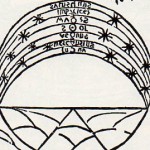
Our modern western calendar reflects the sun’s movements through the seasons and is linked to its motion through the zodiac signs. Just as day follows night, so too Spring follows Winter and reinforces the ancient idea that Time is cyclic. What goes around will come around again.
This is distinctly different to our modern linear approach to Time
There are many periods of time in traditional astrology all based upon observation of various celestial motions such as the aries ingress chart, the eclipse cycles or the saturn return to name but a few.
One useful time cycle is based upon each planet’s synodic cycle with the sun. It is quite commonly used in a variety of ways in traditional astrology and is known as the Minor Planetary Periods.
A planet’s synodic cycle is the time it takes for it to conjunct the sun at the same degree of the zodiac.
Ancient astrologers allotted each planet a specific number of years based solely on this observation. The planetary periods were calculated using the ancient Egyptian year which consisted of 365 days.
Ancient astrologers believed that at the time of a planet’s synodic return, the planet’s power would awaken to take effect and influence an individual’s life.
The minor planetary periods were a very commonly used predictive tool.
| Planet | Number | Rationale |
| The sun | 19 | 235 sun/moon synodic cycles in 19 years |
| The moon | 25 | 309 lunation cycles in 25 years |
| Mercury | 20 | 63 synodic cycles in 20 years |
| Venus | 8 | 5 synodic cycles in 8 years |
| Mars | 15 | 7 synodic cycles in 15 years |
| Jupiter | 12 | 11 synodic cycles in 12 years |
| Saturn | 30 | 29 synodic cycles in 30 years |
The sun’s minor period is its 19 year eclipse cycle when it reoccurs at the same degree of the zodiac once more.
The moon’s minor period is the time it takes for its phases to reoccur on the same days of the year.
The two malefic planets of saturn and mars have a combined total of 45
The benefit planets, the moon, venus and jupiter, have a combined total of 45.
Waxing lyrical and the mind

Ancient philosophers wondered about the nature of memory and the retention of knowledge. They knew a good memory aided a person’s intelligence and learning ability and was not linked to either looks or social standing. They postulated various explanations as to why we remembered things and what memory was. One theory dominated all others. It likened the mind and memory to a block of wax.
Although this now seems like an odd idea, ear wax was believed to come from a sort of wax inside the head itself. Ideas on human biology were paralleled with those of plants and ear wax was thought of in similar kind of way as plant sap, only thicker. It moved slowly and it gently seeped out into the ear canal. Incidentally, hair and fingernails were also thought of in the same way as the leaves of a plant. They too grew from the inside out. In any case, some people had vigorous, robust growth whilst others didn’t and these ideas are likely to be the origin of this ancient theory of memory.
Even today we know just as the ancients did, that too much wax in the ears dulls our sense of hearing, particularly if the wax is very hard. It makes it difficult to hear or take things in. This affects our comprehension and understanding of what others are saying and communication becomes impaired. This affects how we relate to others.
It was believed that the information we received was imprinted or impressed upon the wax inside our head and this was the mechanism of memory retention. Remnants of this idea remain to the present day for we still talk about making a good impression and we can even be impressed by someone. The fact is, first impressions count and indicate that a baseline impression is stamped into our mind. It is very difficult to alter no matter how hard we try. That these verbal metaphors have endured is no surprise for wax continues to be the most popular and best material to use when making an impression of a figure.
The general rule was that the higher the quality of the wax an individual possessed the higher the quality of the mind. The ‘wax of the mind’ could be hard or soft, pure or mediocre in quality but a refined and soft wax was generally regarded to be the most suitable for learning. It allowed an impression to be formed quickly and sharply leading to a well defined, deep and crisp image, free of smudges. The memory was retained which led to a clarity of the mind and a good memory retention free from confusion or the clouding of memory. But any defects or impurities in this head wax affected our memory retention and had knock on effects on our intelligence and thought processes.
A soft wax gave an initial good impression but the outlines of the memory shapes would soon begin to fade and become indistinct as the wax slowly reverted to its original shape. This led to a loss of information and forgetfulness. People who were simple minded were thought to have very soft wax inside their head, hence the expression soft in the head. The term empty headed meant that one had little or no wax in the first place.
A hard wax meant that an impression was more difficult to obtain in the first place. This made learning a slow process and required greater effort. One had to think much harder, going over the same thing several times until the information was retained. It was believed that this is what led to someone having a rigid and inflexible mind.
Very hard wax was considered even worse for it made it extremely difficult to get an image at all and this ultimately led to an individual who lacked any depth of thought or understanding.
It was believed in ancient Greece that between the age of four and fourteen was the best time for moulding the mind and shaping it via education. This period of life was ruled by the planet mercury which is the natural significator and governor of our rational mind and intellect.
Ultimately how our mind works affect our intelligence. The way we use it is described as our Wit. Wit can refer to many things that require a good mind. What they all have in common is the expression of intelligence. We all know that someone can live off their wits and calling someone witty or a wit implies an intelligent person, imbibed with a good intellect with an adept mind who can demonstrate mental ability and agility.
Mercury ruled the tongue, the organ responsible for speech and the instrument through which we communicate our understanding. If we are mentally at a loss, finding ourselves exasperated, we can become tongue tied or even be at our at our wit’s end. The terms ‘nit-wit’ and ‘half-wit’ still remain in common parlance, continuing to be used as derogatory terms.
Memory and memory problems are traditionally ruled by mercury.
The via combusta
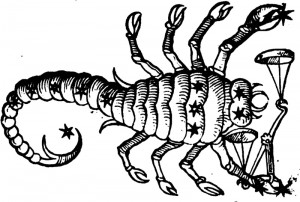
The via combusta is also known as the burned path or the fiery road, names that make the area sound grim. But where is it exactly? Although in the distant past there were a few different ideas on its exact location, accepted astrological tradition states it to be a 30 degree stretch between 15 degrees libra and 15 degrees scorpio inclusive.
In antiquity libra was actually part of the constellation scorpio and Claudius Ptolemy refers to the constellation of libra as ‘the Claws of the Scorpion’(1). It has always been regarded as an ominous area of the chart throughout the ages. Ancient stargazers worried about any planet arriving at this point, symbolically caught in the scorpion’s claws. We will probably never know the reason for the malefic association with this stretch of the zodiac but the reputation of the via combusta persists.
In an electional chart it served as a warning, foretelling of difficulty or trouble ahead – not a good indiction to commence any venture. In a horary chart it served the same purpose and was an indication to defer judgement until the astrologer was better informed.
Libra marks the start of the Autumn Equinox when the sun’s power wanes but both lights are affected in the signs that contain the via combusta. The sun is in fall in libra, the moon in scorpio. This area is opposite their exaltation signs of aries and taurus.
Further uncongeniality is emphasised if we recall that libra is the exaltation of saturn and scorpio is the domicile of mars. The greater and lesser lights are overcome by the greater and lesser malefics. The power of the luminaries is weakened hence this area’s link with danger. Because the sun and moon represent one’s life force and soul respectively, anything that diminishes or obscures them should definitely be avoided.
1. Claudius Ptolemy. Tetrabiblos. Book 1. Chapter 9.
The planetary day and personality
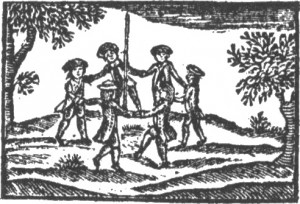
It was believed in days gone-by that a child’s temperament could be influenced by the day of the week it was born. The following old poem was designed to teach children the days of the week and is one of many old fortune-telling poems illustrating a traditional belief in the planetary link between the days of the week, a child’s personality and what fate had in store for them. There are variations of the poem. I will use the one I know, taught to me in primary school in Scotland where the word ‘bonnie’ is commonly used – I still use it myself! It is worth remembering that the meaning of words change over the years so planetary links are not always apparent. A good dictionary is also a useful tool for astrologers. Some words have a totally different meaning nowadays so bear this in mind as you read the poem.
Monday’s child is fair of face,
Tuesday’s child is full of grace,
Wednesday’s child is full of woe,
Thursday’s child has far to go,
Friday’s child is loving and giving,
Saturday’s child works hard for his living,
And the child that is born on the Sabbath day
Is bonnie and blithe, and good and gay.
Monday
Fair obviously refers to beauty but since the moon reflects the light of the sun it’s a less robust kind of beauty, it’s fairer, pleasing, rather than the knockout variety. Fair means just and free from bias but the word fair is also linked to auspiciousness and good fortune. So, according to the rhyme, anyone born on Monday will have a pleasing countenance, a balanced view and have a lucky life. The moon is the ruler of our emotions and the non-rational mind of our gut reactions and intuition, neither of which are necessarily based on established fact. So it’s just as well that these children have a bit of luck on their side. The moon is hidden under the sun’s beams at the time of a new moon, becoming visible in the sky as a thin crescent after a few days later. Being the lesser light it is fitting that the moon governs the day after the sun’s day of Sunday. This reflects the Thema Mundi where both the sun and moon’s domiciles and exaltations are adjacent.
Tuesday
Full of grace from a day ruled by mars? It seems like a contradiction for mars is the god of war. But the drive of the battlefield mars is equally useful in daily life as in warfare. In both instances, attack and aggression can be planned. Our physical energy and enthusiasm can be channelled in various ways. Athletes, dancers, acrobats and those who perform their daily physical tasks with precision and dexterity, like the village blacksmith or a stonemason, have one thing in common. They are bodily fit with well practised skills at their disposal. Smoothness of movement and effortless dexterity is second nature to them. Mars joys in the 6th house of drudgery, slavery and hard work so practise truly does make perfect. These finely honed physical skills are the product of controlled physical strength and stamina. This is why Tuesday’s child is full of grace. They say that a healthy body leads to a healthy mind and this will give the individual the attractive qualities of good manners and a sense of appropriateness and decency that make this child full of grace.
Wednesday
Full of woe nowadays refers to grief, bemoaning and bewailing one’s lot in life. In the past these attributes were normally linked to having a lot of responsibilities, challenges and a liabilities brought about by managing the affairs of others. As mercury governs this mid-week day he is appropriately sandwiched between the other planets, exactly where a scribe or messenger should be for mercury was messenger of the gods and at their service. Mercury is the ruler of our rational mind and intellect so it is well suited to tasks of this kind, channelling them to the matter at hand with precision and excellence. In mythology it was believed that mercury could be mischievous. A heavy burden would kept mercury constantly occupied with no free time to do as he pleased, hence he was full of woe. Mercury joys in the first house which has general signification over the head and its contents which includes the brain.
Thursday
This child has far to go and this brings to mind long journeys to foreign places. It seems as if this kid has hit the jackpot! But until recent times most people didn’t travel far from their home town, village or hamlet unless on a religious pilgrimage. These were quite common in Medieval times. Apart from the religious aspect, travel gives people the opportunity to meet and experience new people, new cultures and the realisation there was something beyond their ken. This can be paralleled with religion. Travel does indeed broaden the mind. However travel can also be internal and might involve study and contemplation for it is via knowledge that we better ourself. We gain a greater understanding of the world, a positive trait that can take us far in life. Jupiter and his benefic nature enriches us bringing us closer to the Divine plan. However, the road to enlightenment is a long one and we will have far to go before we reach our journey’s end, if we ever do.
Friday
This day is governed by venus, traditionally the lesser benefic and the goddess of love, beauty and harmony. Venus is all about pleasure, particularly pleasures that are shared. This may give Friday its feel good factor. It was believed to be a good day for meeting friends and for courting. However, Friday wasn’t all plain sailing being considered a very unfortunate day. It was a particularly bad day to set sail and it was also traditional to hang criminals on a Friday and we still talk of Friday the 13th. Friday then had positive and negative associations for it was believed that Eve tempted Adam with an apple on this day. Since venus rules our flesh and our passion nature it’s an explosive combination and there is risk of being carried away. The rhyme gives indications for moderation. Friday’s child is loving and giving rather than being loved and given to. This child could be exploited, easily taken advantage of. It is worth keeping in mind that venus joys in the 5th house of the Thema Mundi, the house of pleasure.
Saturday
This child will work hard for a living and this child initially seems to have drawn the short straw, getting a raw deal. As saturn is the greater malefic we wouldn’t expect anything saturn promises to be a breeze. But It’s worth bearing in mind that in olden days working hard was seen as a virtue, a positive trait. Hard work requires self discipline and a realistic outlook. By looking back over a completed job well done, we get a sense of achievement and fulfilment, developing a sense of fortitude and self confidence. These are highly desirable skills that provide a solid foundation upon which to build a life. Nowadays in our ‘why wait’ culture, avoidance of hard work is encouraged. This is not a realistic way of life, neither is it productive. Our hard working forebears would tell us if they could that although Saturday’s child works hard for a living, they are richer for it.
Sunday
As the poem suggests this child is born with a sunny disposition. The word bonnie describes someone who is physically attractive and appealing. In bygone days a blithe person was thought of as a lighthearted soul, happy and without a care in the world but nowadays it has negative connotations like self-centred, thoughtless and even careless. The sun is at the centre of heaven and instills vitality and life with its rays. It rules our inner spiritual being so it was believed that children born under this benefic influence would both enshrine and reflect these same qualities giving these children a positive outlook in life and a generous nature.
